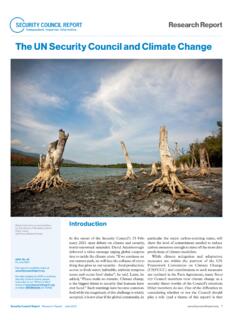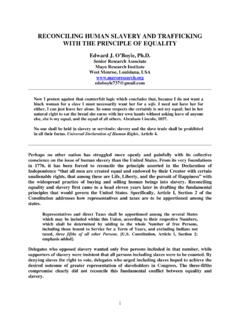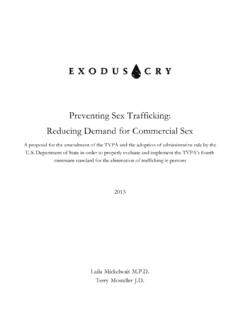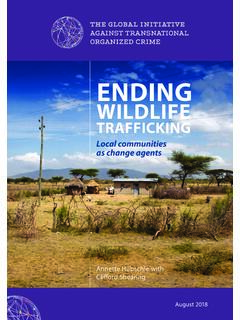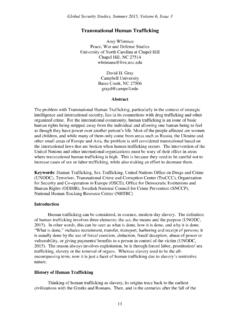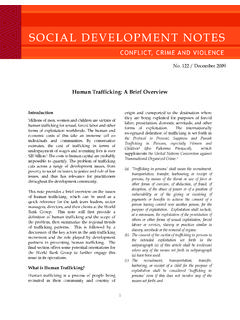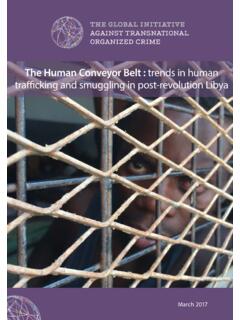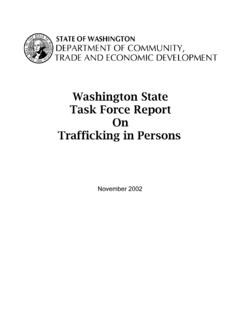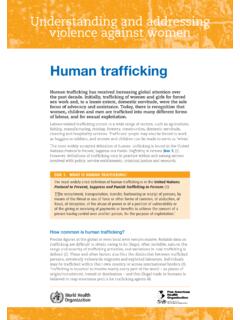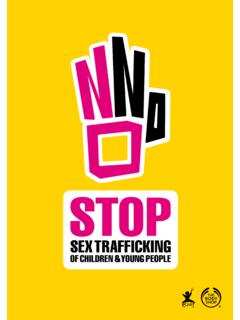Transcription of United Nations S Security Council
1 United Nations S/2016/949 Security Council Distr.: General 10 November 2016 Original: English 16-18325 (E) 181116 *1618325* report of the Secretary-General on the implementation of measures to counter trafficking in persons I. Introduction 1. The present report is submitted pursuant to the statement of the President of the Security Council of 16 December 2015 (S/PRST/2015/25), by means of which the Council requested me to report back to it on progress made in 12 months to implement better existing mechanisms countering trafficking in persons and to carry out steps requested in the statement. The assessment and observations contained in the present report are based on information provided by Member States and the United Nations system. II. Recent developments concerning trafficking in persons related to conflict 2. Linkages between conflict and trafficking in persons, particularly of women and girls, have most recently been identified by the Special Rapporteur of the Human Rights Council on trafficking in persons, especially women and children, as a result of extensive research conducted since mid-2015 and documented in her reports to the Council (A/HRC/32/41 and ) and the General Assembly (A/71/303), in which she called for prioritizing the protection of people during conflict and of people fleeing conflict from all forms of human trafficking .
2 3. On the occasion of the 2016 World Day against trafficking in Persons, I noted that human traffickers prey on the most desperate and vulnerable, and called on the international community to tackle crises that force people across borders, seas and deserts. Armed conflicts and humanitarian crises expose those caught in the crossfire to increased risk of being trafficked both in and beyond conflict zones and exacerbate many factors that increase individual and group vulnerability to human trafficking , such as lack of economic livelihood, discrimination and gender-based violence, and that have a disproportionate impact on groups that already lack power and status in society, including women, children, migrants, refugees and the internally displaced. S/2016/949 16-18325 2/20 A. trafficking in persons beyond the conflict zone 4. The consequences for people compelled to move because of conflict cannot be ignored; migrants who move out of necessity rather than free choice are at greater risk of trafficking in persons throughout their migratory experience.
3 In the 2016 global report on trafficking in Persons,1 the United Nations Office on Drugs and Crime (UNODC) confirms that trafficking in persons is largely an international phenomenon and that cross-border trafficking flows generally follow overall migratory flows. It notes that, as reported by the 156 Member States that contributed to the report , the majority of trafficking victims detected globally (about 60 per cent) are foreigners in the country where they have been identified, most of them migrants. In late 2015, the International Organization for Migration (IOM) published research on addressing human trafficking in crises,2 in which it analysed the links between human trafficking , exploitation and crisis, including conflict, and recommended that counter- trafficking activities should start at the outset of any crisis and before evidence of trafficking and/or exploitation surfaces. 5. Escaping from a conflict zone or arrival at a sought-after destination does not always shield those fleeing conflict from becoming victims of trafficking ; specific vulnerabilities increase the risk of becoming prey to criminals.
4 In her reports, the Special Rapporteur on trafficking in persons, especially women and children found that refugees and asylum seekers, including numerous unaccompanied children from the Sudan and Somalia, have been kidnapped or lured from refugee camps or while en route, sold and subsequently held captive in Libya or in the Sinai desert for purposes of exploitation through extortion, and that migrants fleeing conflict in the Sudan have been targeted for organ harvesting in Egypt. Irregular migrants, including unaccompanied children, may often be compelled to work in exploitative circumstances to sustain themselves and/or to support their families. Iraqi and Syrian refugee children in other Middle Eastern States work in textile factories, construction and the food service industry, and as agricultural workers or street vendors in conditions amounting to forced labour. According to the Special Rapporteur, there appear to be organized systems within some refugee camps for facilitating similar work arrangements.
5 Information collected for the global report on trafficking in Persons has shown an increasing number of trafficking victims from conflict-affected countries such as the Syrian Arab Republic, Iraq and Somalia in countries in Europe, Asia and the Middle East. 6. The nexus between conflict-related sexual violence and human trafficking and their cross-border dynamics were acknowledged in my report on conflict-related sexual violence (S/2016/361 ), in which I provided information on smugglers demanding sex as payment of passage and on an evolving criminal infrastructure designed to exploit refugees through human trafficking , commercial sex and sexual slavery, including in the context of the current mass migration movements. 7. In my report to the high-level plenary meeting of the General Assembly on addressing large movements of refugees and migrants (A/70/59), held on _____ 1 Forthcoming. 2 International Organization for Migration, Addressing Human trafficking and Exploitation in Times of Crisis: Evidence and Recommendations for Further Action to Protect Vulnerable and Mobile Populations (Geneva, 2015).
6 S/2016/949 3/20 16-18325 19 September 2016, I noted that although exact figures were difficult to obtain, the risk of human trafficking significantly increased in large movements of refugees and migrants. The outcome document of the high-level plenary meeting, the New York Declaration for Refugees and Migrants,3 paves the way for two new global compacts to address this issue. In the Declaration, Member States make a commitment to combat human trafficking with a view to its elimination, including through targeted measures to identify and assist victims of human trafficking and those at risk, as well as to prevent human trafficking among those affected by displacement, taking into account the particular vulnerabilities of women and children. B. Human trafficking in conflict situations 8. Civilian populations are viewed by some armed groups as a resource or commodity to be trafficked, as evidenced recently by the abduction and cross-border trafficking of Syrian and Iraqi women and children and documented in my report on conflict-related sexual violence.
7 It is well known that internally displaced and refugee women and girls in areas controlled by the Islamic State in Iraq and the Levant (ISIL)4 have been sold or forcibly married to fighters in armed groups or to wealthy foreigners. Instances of trafficking of migrant workers into conflict zones through deceptive and/or fraudulent recruitment practices have also been reported by the Special Rapporteur. 9. Specific, sometimes new, forms of trafficking can emerge during conflict, including when there is a high risk or incidence of atrocities, such as war crimes and crimes against humanity, including genocide. According to a report by the International Centre for Migration Policy Development,5 some forms of trafficking , including for forced marriage and exploitation in armed conflict, have increasingly emerged following the beginning of the Syrian crisis and can be seen as directly related to the war. At the same time, the report noted that most related trafficking is not committed by highly organized criminal networks, but rather by family members, acquaintances and neighbours.
8 10. In recent years, terrorist groups such as ISIL and Boko Haram have openly advocated for and engaged in sexual enslavement and trading in women and girls through human trafficking . In its report to the Human Rights Council entitled They came to destroy: ISIS crimes against the Yazidis (A/HRC/32 ), the Independent International Commission of Inquiry on the Syrian Arab Republic concluded that the forced displacement and sale of women and girls by ISIL amounted to the crime of human trafficking . In my report on children and armed conflict (A/70/836-S/2016/360), I reported that in areas controlled by ISIL, girls reportedly were vulnerable to forced marriages to fighters, while Yazidi girls captured in Iraq were reportedly trafficked into the Syrian Arab Republic and used as sex slaves. _____ 3 General Assembly resolution 71/1. 4 Also known as Da esh. The terms are used interchangeably by various stakeholders.
9 5 Targeting Vulnerabilities: The Impact of the Syrian War and Refugee Situation on trafficking in Persons: A Study of Syria, Turkey, Lebanon, Jordan and Iraq (Vienna, 2015). S/2016/949 16-18325 4/20 11. On 16 September 2016, UNODC appointed Nadia Murad Basee Taha, a survivor of ISIL human trafficking , as its Goodwill Ambassador for the Dignity of Survivors of Human trafficking . This is the first time a survivor of human trafficking has been appointed Goodwill Ambassador. Ms. Murad will focus on advocacy initiatives and on raising awareness on the plight of victims of trafficking , especially refugees, women and girls. C. Human trafficking , armed conflict and organized crime 12. In my report on conflict-related sexual violence, I also highlighted that the use of sexual violence by terrorist groups to increase their power, recruitment base and revenue through human trafficking should be part of the global discourse and action on curbing financial flows to violent extremists.
10 In my reports on the threat posed by ISIL to international peace and Security (S/2016/92 and S/2016/501), I noted that trafficking of women and girls remained a critical component of the financial flows to ISIL and its affiliates. I cited tactics such as the ransoming and sale of women and girls to mobilize resources and fund operations, with terrorists using modern technologies such as encrypted messaging to keep online bidding processes secret. 13. These findings were echoed in the fourth global survey of the implementation by Member States of Security Council resolution 1373 (2001) (S/2016/49, annex), which noted that cooperation with organized criminal networks provided terrorist groups with access to funding and resources through human trafficking and smuggling of, inter alia, human beings, in particular women and girls. States border control measures are thus vulnerable to systematic exploitation by human traffickers operating in close collaboration with terrorist groups.


